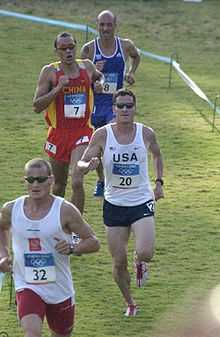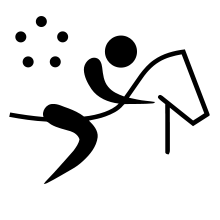Modern pentathlon
The modern pentathlon is an Olympic sport that comprises five events: fencing, 200 m freestyle swimming, show jumping, and a final combined event of pistol shooting, and a 3200 m cross-country run.[1] The sport has been a core sport of the Olympic Games since 1912, and since 1949 an annual World Championship has been held.
Originally the competition took place over four or five days; however in 1996 a one-day format was adopted in an effort to be more audience-friendly.[1] However, modern pentathlon, despite its long Olympic history, has had to justify its inclusion in the modern Olympic Games on frequent occasions. On February 11, 2013 in Lausanne, the IOC confirmed modern pentathlon once again as one of the 25 core sports of the Olympic program through until 2020. The governing body, Union Internationale de Pentathlon Moderne (UIPM), administers the international sport in more than 90 countries in all the continents of the world.[2]
History

The foundation of the modern pentathlon is disputed. On the one hand Baron Pierre de Coubertin, the founder of the modern Olympic Games,[1] claimed authorship. On the other hand Viktor Balck, the President of the Organizing Committee for the 1912 Games showed that he made use of the long tradition of Swedish military multi-sports events, to created a manageable modern pentathlon.[3] The name derives from the Greek penta- "five" and -athlon "contest".[1] The addition of modern to the name distinguished it from the original pentathlon of the ancient Olympic Games, which consisted of the stadion foot race, wrestling, long jump, javelin, and discus. As the events of the ancient pentathlon were modeled after the skills of the ideal soldier of that time, Coubertin created the contest to simulate the experience of a 19th-century cavalry soldier behind enemy lines: he must ride an unfamiliar horse, fight with pistol and sword, swim, and run.[1] In the 1912 Games, with only officers competing, they were, however, permitted to use their own horses. Up to the 1952 Olympics the ordinary cavalry soldier was considered a professional athlete, as he was riding and training horses for a living, while the officer was the amateur. As long as there was no official international federation for Modern Pentathlon an IOC committee was set up for the sport making use of the expertise of IOC members.[4]
The event was first held at the 1912 Olympic Games, and was won by Swedish athlete Gösta Lilliehöök. The modern pentathlon has been on the Olympic program continuously since 1912. A team event was added to the Olympic Games in 1952 and discontinued in 1992. After much lobby work of the President of the German Modern Pentathlon Federation Prof. Wilhelm Henze, women were for the first time admitted on a trial basis at the World Championships in San Antonio in 1977, and at the official world championships in 1981.[5] An event for women was added in 2000.[1] A World Championship is held every year. The competitions include Men and Women's Individual and Team event together with relay events for Men and Women and, since 2010, a mixed relay event.
Except for the fencing competition, athletes do not directly compete against one another in the five events. Athletes gain points for their performance in each event and scores are combined to give the overall total. This is similar to the procedure for the decathlon in track and field athletics. However, an innovation was introduced in 2009 to make the finale of the pentathlon more exciting. The last event is the Combined event: laser pistol shooting and cross-country running. Competitors are ranked according to their score from the first three disciplines and given start times accordingly, with the leader going first, and other starting times being dependent on the number of points already scored. The first person to cross the finish line, therefore, will be the overall points leader and win the pentathlon. This method of finishing the competition would also eventually find use in winter events; the Gundersen method details a means by which a similar finish is achieved in the Nordic combined.
- The fencing discipline uses the épée. The competition is a round-robin, meaning each competitor will face all the other competitors once. Each match lasts up to one minute; the first fencer to score a hit wins instantly. Double hits are not counted. If neither scores within one minute, they both lose the match.
- The swimming discipline is a 200 m freestyle race. Until the 2000 Olympics, the distance was 300 metres.[6] Competitors are seeded in heats according to their fastest time over the distance.
- The riding discipline involves show jumping over a 350–450 m course with 12 to 15 obstacles. Competitors are paired with horses in a draw 20 minutes before the start of the event. This unusual skill—the riding of a horse that is previously unknown to the rider—is unique in the world of sport and is one of the elements which gives Modern Pentathlon its special character.
- Until 2009, the shooting discipline involved using a 4.5 mm air pistol in the standing position from 10 metres distance at a stationary target. The format was that of the 10 metre air pistol competition: each competitor had 20 shots, with 40 seconds allowed for each shot. In 2009 the combined event was born. This involved a combination of the running and shooting events so that each competitor ran three 1000 m laps, each prefaced by hitting five targets with a pistol. Beginning with the Rancho Mirage World Cup (Feb 2011), the pistols changed to a laser instead of an actual projectile. There is a slight delay between the trigger pull and the laser firing, simulating the time it would take for a pellet to clear the muzzle.[7]
- The running discipline involved a 3 km cross-country race until 2009 when it combined with the shooting event. From the start of the 2013 season, the combined event has changed again to consist of four 800m laps each prefaced by laser shooting at five targets. This change is intended to restore some of the importance of the shooting skill felt to have been lost in the original 2009 combined event. Until the 2000 Olympics, the distance was 4 kilometres.[6]
The combined event is similar to the biathlon at the Winter Olympic Games, which combines cross-country skiing with rifle shooting. However, whereas biathletes carry their rifles while skiing, pentathletes will not carry their pistols while running. The change has been criticized as altering too radically the nature of the skills required. The New York Times asked whether the name ought to be changed to "tetrathlon" given that two of the five disciplines had been combined into a single event.[1]
In the new format, in each of the four rounds of firing, athletes have to successfully shoot five targets, loading the gun after each shot. They may resume running once they have five successful hits, or once the maximum shooting time of 50 seconds has expired. Misses are not penalised.[1][8] The new format maintains the principle that the overall winner will be the first to cross the finish line.[1]
See also
- Pentathlon
- List of Olympic medalists in modern pentathlon
- Modern pentathlon at the Summer Olympics
- World Modern Pentathlon Championships
References
- ↑ 1.0 1.1 1.2 1.3 1.4 1.5 1.6 1.7 1.8 Branch, John (November 26, 2008). "Modern Pentathlon Gets a Little Less Penta". New York Times. Retrieved 2008-11-27. This recent combination of the shooting and running phases creates an exciting conclusion to the competition.
- ↑ "Special Edition: Refuting IOC's Plan to End Modern Pentathlon Competition". The Sport Journal. Fall 2002. Retrieved 2012-08-22.
- ↑ Sandra Heck: Von Spielenden Soldaten und kämpfenden Athleten. Die Genese des Modernen Fünfkampfes. Göttingen: V & R Unipress. 2013, ISBN 978-3-8471-0201-4
- ↑ Arnd Krüger: Forgotton Decisions. The IOC on the Eve of World War I, in: Olympika 6 (1997), 85 – 98. (http://www.la84foundation.org/SportsLibrary/Olympika/Olympika_1997/olympika0601g.pdf)
- ↑ Uta Engels: "Now the Problem: Modern Pentathlon for Ladies." Zur Rolle Prof. Dr. Peter-Wilhem Henzes bei der Entwicklung des Modernen Frauenfünfkampfes, in: Arnd Krüger & Bernd Wedemeyer (eds.): Aus Biographien Sportgeschichte lernen. Festschrift zum 90. Geburtstag von Prof. Dr. Wilhelm Henze. Hoya: Niedersächsisches Institut für Sportgeschichte 2000, S. 47 -66. ISBN 3-932423-07-0
- ↑ 6.0 6.1 "Modern Pentathlon". 'Good Luck Beijing'. 2007-03-10. Retrieved 2008-11-27.
- ↑ "Can Lasers Save the Modern Pentathlon?". 2012-08-12.
- ↑ "Rules for Combined Event Running and Shooting" (PDF). UIPM. Retrieved 2012-08-12.
External links
| ||||||||||
| ||||||||||||||||||||||||||||||||||||||

